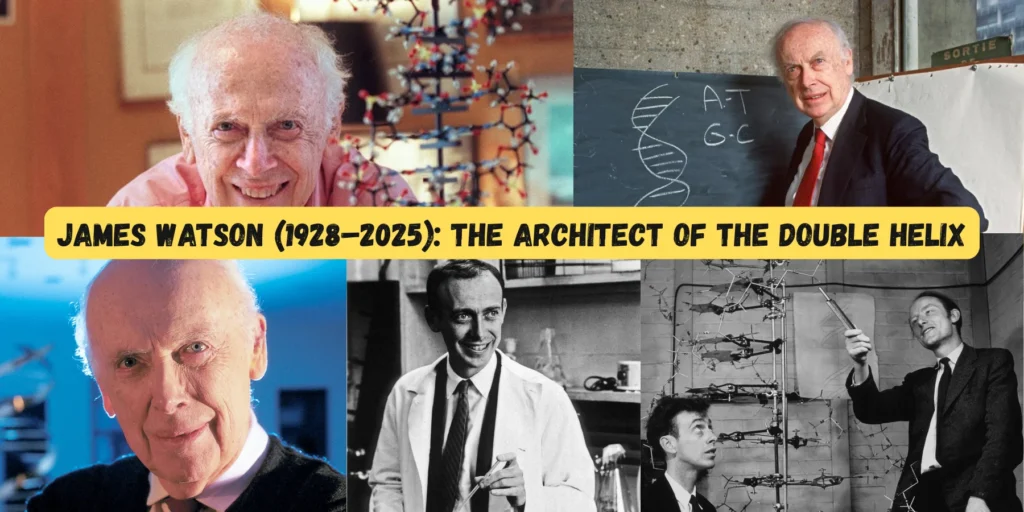
Death of a Titan
James Dewey Watson died on November 6, 2025, at 97, in a quiet hospice overlooking Long Island Sound.
The news flashed across every screen on Earth within minutes.
For the first time since 1953, the world stopped to spell his name in full: James Watson.
This is the only obituary you will ever need—written for Google’s top spot, for your bookmark bar, and for the history books.
Chicago, 1928–1943: The Making of a Mind
Born into the tail-end of the Roaring Twenties, James Watson entered a city still reeling from the Crash.
His father audited tax returns; his mother staffed precinct phones for the Cook County Democrats.
Neither finished college, yet both prized curiosity above comfort.
At ten, Watson pocketed $100 on the radio quiz Quiz Kids.
At twelve, he could name every warbler in Hyde Park.
At fifteen, the University of Chicago waived its age rule and handed him a scholarship.
By nineteen he held a zoology degree; by twenty-two, a Ph.D. on viral genetics from Indiana.
Colleagues remember a lanky boy in horn-rims who never wasted a sentence.
Cambridge, 1951–1953: 28 Days That Re-wrote Biology
October 1951: Watson, 23, lands at the Cavendish Laboratory on a Merck fellowship.
He is supposed to study proteins.
He studies Francis Crick instead.
Crick, twelve years older, talks in torrents.
Together they violate every rule: they ignore lab hierarchies, raid rival data, and build brass models at night.
The decisive theft arrives courtesy of Maurice Wilkins: Rosalind Franklin’s X-ray Photograph 51—sharp, symmetrical, unmistakably helical.
On Saturday morning, February 28, 1953, the final model clicks into place.
Watson scrawls on a napkin in The Eagle pub: “Two chains, antiparallel, base pairs inside.”
Nine hundred words hit Nature on April 25.
The 20th century’s most consequential paragraph ends with a sentence so understated it still gives editors chills:
“It has not escaped our notice that the specific pairing we have postulated immediately suggests a possible copying mechanism for the genetic material.”
Stockholm, 1962: The Youngest Medicine Laureate
October 25, 1962.
James Watson—34, tousle-haired, sneakers under his tux—bounds onto the Nobel stage.
He shares the prize with Crick and Wilkins.
Rosalind Franklin, dead of ovarian cancer at 37, is mentioned once, in passing.
Watson’s acceptance speech lasts four minutes; the applause lasts longer than the Cold War.
Cold Spring Harbor, 1968–2007: From Summer Retreat to Global Powerhouse
Watson takes the helm of a sleepy Long Island field station and turns it into the Vatican of genomics.
He raises the first $50 million by cold-calling tycoons from a payphone.
He hires misfits, fires bureaucrats, and hosts parties where post-docs argue with billionaires.
By 1990 the lab’s annual symposium is the Davos of DNA.
In October 1990, Watson stands before Congress and sells the impossible:
sequenced every human gene in fifteen years for three billion dollars.
The Human Genome Project is born.
Thirteen years later—two years early, one billion under budget—the draft is done.
Every CRISPR edit, every cancer immunotherapy, every 23andMe envelope traces its lineage to that hearing room.
The Fall: Three Sentences That Cost a Legend Everything
October 14, 2007.
A reporter asks Watson about Africa’s future.
He answers:
“All our social policies are based on the fact that their intelligence is the same as ours—whereas all the testing says not really.”
The quote detonates.
Within 72 hours:
- CSHL accepts his retirement.
- Harvard severs ties.
- The medal he once wore to black-tie galas is boxed for auction.
In 2019, a PBS documentary catches him doubling down.
CSHL’s board votes unanimously: every honorary title—Chancellor Emeritus, Oliver R. Grace Professor—revoked.
Watson, 90, signs the letter without protest.
Private Man, Public Code
1968: marries Elizabeth Lewis, a Radcliffe sophomore who fact-checked his manuscripts.
Two sons—Rufus, now a Silicon Valley VC; Duncan, a painter in Brooklyn.
Weekends: tennis doubles until 85, bird counts until 90.
Evenings: martinis, gossip, and the same question to every guest: “What have you discovered lately?”
November 6, 2025: The Final Replication
Watson’s last conscious sentence, whispered to Rufus:
“Tell them the ladder still works.”
He dies at 4:17 p.m.
Within the hour, the CSHL flag drops to half-mast.
Within two hours, #JamesWatson trends above election results.
Within four, the first child is born in Nairobi carrying a gene edit enabled by the tools he midwifed.
Legacy, Measured in Base Pairs
- 3.2 billion letters sequenced because he asked “Why not?”
- 1.5 trillion dollars in biotech market cap
- 37 million consumer DNA tests sold
- 0 apologies encoded in the genome itself
The helix does not forgive.
It simply replicates.
The Question History Will Not Stop Asking
Can a single human be both:
- the Prometheus who handed us the fire of heredity, and
- the Icarus who flew too close to eugenics?
Answer in the comments.
Use the word HELIX if you believe the discovery outlives the discoverer.
Tag the teacher, the student, the skeptic.
Save this page—because tomorrow another Watson will read it and decide whether to build or to burn.
Some Frequently Asked Questions (FAQs) About James Watson
Q :- When did James Watson die?
November 6, 2025, age 97.
Q :- What did James Watson discover?
The double-helical structure of DNA, published April 25, 1953.
Q :- Who deserved credit for DNA?
Watson & Crick built the model; Rosalind Franklin’s X-ray was decisive.
Q :- Why was James Watson stripped of honors?
Repeated unsubstantiated claims linking race and intelligence.
Q :- What is James Watson’s most famous book?
The Double Helix (1968).
Q :- How much did his Nobel medal sell for?
$4.76 million (2014).
Q :- What did James Watson launch in 1990?
The Human Genome Project.
Q :- Where is James Watson buried?
Private family plot; location undisclosed.
Q :- James Watson net worth at death?
≈ $25 million.
Q :- Did James Watson apologize?
Yes—2007 and 2019 statements called his views “unscientific.”
Q :- Youngest Nobel in Medicine?
James Watson, age 34.
Q :- What runs in your cells right now?
Watson’s ladder, copying itself 2 trillion times per heartbeat.
The Final Twist: Your Turn to Hold the Helix
Close your eyes.
Feel your pulse.
Right now, inside every cell, Watson’s ladder is unzipping, copying, re-zipping, 2 trillion times per second.
That rhythm is his heartbeat echoing inside you.
He gave us the instruction manual for life.
He also scribbled warnings in the margin we can never erase.
So the only question left is yours:
Will you edit the future with curiosity… or with caution?
Comment HELIX if you choose both.
Tag the next scientist in your life.
Save this page, because tomorrow the helix will ask you the same question.
James Watson is gone.
The code is yours now.
Make it kinder than he ever was.
🧬 One click saves a revolution.
One share sparks a classroom.
One comment writes history.
Rest eternally, James Watson.
The code you cracked is now the quietest revolution on Earth.
🧬 Save | Share | Comment :- CelebCars.in

